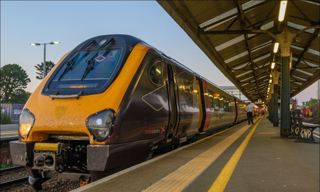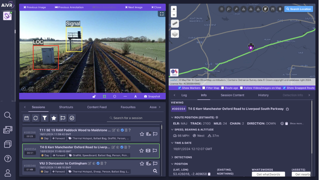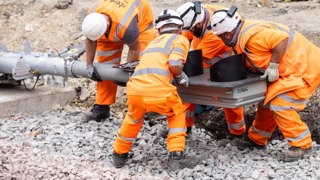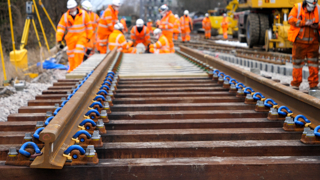
The scrapping of 67003 marks a sad moment in the history of the Class 67s which were bought principally for a market that disappeared within a few years of their arrival.

The scrapping of 67003 marks a sad moment in the history of the Class 67s which were bought principally for a market that disappeared within a few years of their arrival.
In April 2024, Pip Dunn looked at the locomotives' unfortunate history.
In the mid-1990s, Britain’s railways were going through a revolution - the private sector was taking over.
But privatising a natural monopoly was never going to be easy. It was all very well selling off the railways and getting them off the taxpayers’ balance sheet, but they were (and still are) also a public service.
Apart from rail enthusiasts, tourists and travel writers, few people travel on a train for the sake of travelling on a train. They are there to serve the public, taking people and goods from A to B (and often onto C) and back again. They are a vital tool for commuters and business travellers during the week, and for leisure and non-business travellers at the weekends.
While the passenger operations were split into franchises of (typically) seven or 15 years, the freight industry was ripe for selling off without the need for any public subsidy.
The plan had been to create six freight operations and sell them off, ideally to different buyers which would then create competition.
But it didn’t work that way, as five of the six companies were sold to one organisation - Wisconsin Central Transportation Corp, with its charismatic chairman Ed Burkhardt. The other, Freightliner, was sold to a management buyout. All were sold at well below their actual asset value.
Now owning the vast majority of the UK’s rail freight operations, including mail, charters and eventually the Channel Tunnel operations, WCTC created a new company - English, Welsh & Scottish Railway (EWS).
One of Burkhardt’s earliest and biggest challenges was addressing the condition and age of the locomotive fleet he had inherited.
A mix of tired, unloved and potentially unreliable locomotives formed the vast bulk of the EWS fleet. Many dated from the late 1950s and early 1960s. The newest locomotives in the fleet were the heavy freight Class 60s from 1989-91, the AC electric Class 90s from 1990, and the complex Class 92 electrics, some of which still didn’t work properly and were heavily restricted on where they could work.
Within weeks of the takeover, Burkhardt had placed an order with EMD for 250 Class 66s. To be made in Canada, these heavy freight locomotives would replace (initially) the Class 31s, ‘33s’, ‘37/0s’, ‘47s’ and ‘56s’. In reality, they would also allow EWS to get rid of the ‘58s’, ‘60s’ and ‘73s’.
But there were some jobs that the Class 66 - a 75mph freight locomotive - could not cover: mail, parcels, and charters.
EWS had a large contract with the Royal Mail, having purchased Rail Express Systems (RES) as one of the five companies it acquired. In fact, RES had actually been bought in November 1995, before Loadhaul, Mainline Freight and Transrail were secured in February 1996 (Railfreight Distribution would follow in March 1997).

Class 66s were not suitable for the RES work, which relied on 95mph Class 47s for any diesel-hauled trains and 100mph Class 86/90s for any of the electric-hauled work.
To fill that void, Burkhardt ordered 30 Class 67s, which shared a lot of the driveline of the Class 66 but were 125mph-capable Bo-Bo diesel electrics. They would also allow EWS to replace Class 47s on charter work, which included the VSOE Pullman and the Royal Train.
The order for a new mail and passenger locomotive of at least 100mph capability had been discussed right at the start of the EWS era.
Initially, what we know now as a Class 66 was going to be a Class 61, with ‘61/0s’ for freight and ‘61/4s’ for mail and passenger use. Then the plan was Class 61s for freight and ‘66s’ for passenger/mail. That, as we now know, became Class 66s for freight and Class 67s for the mail.
The order for the Class 67s was placed in the summer of 1997 at a value of £43 million (so £1.43m each), and they would be built under sub-contract to EMD by Alstom at its Valencia factory in Spain. This site is now owned by Stadler and has built the Class 68s, ‘88s’ and ‘93s’, and is now building the Class 99s.
The first ‘67s’ were built in the summer of 1999 and underwent testing in Spain - although there was a limit as to where they could run as they were built to standard gauge, and much of Spain had a wider 1,668mm gauge. However, some high-speed lines were built to standard gauge, so the route through La Sagra were suitable to test 67002.
Construction of the ‘67s’
The Class 67 body was of a stressed monocoque construction technique. And while a standard Alstom design, they shared the same ribbed bodysides as a Class 66. The bogies were the tried and tested technology of the standard Alstom ‘H-frame’ design, and they only had four axles and traction motors.
There were naturally many similarities to a Class 66, and the ‘67s’ used the same 12N-7103G3B-EC two-stroke engine rated at 3,300hp. However, a major difference was that the ‘67s’ had a Head End Power (HEP) generator (HEP is American terminology for Electric Train Supply), which prompted a slight change to the electrics.
The braking system was similar to the ‘66s’ but was improved because of the much higher top speed of a ‘67’. Many of the cab controls were the same as on a ‘66’, which made driver training much easier.
Traction motors were the same D43/FM design as a ‘66’, but they were frame-mounted rather than axle-hung to reduce the unsprung mass, thus reducing forces on the track and so limiting track wear.
Although the ‘67s’ were designed for 125mph, the reality was they would be unlikely to go above 110mph. In fact, the scope for EWS to exploit the Class 67s at anything over 100mph would be limited on both charters and mail work.
The ETS index on a Class 67 was 66, and the system was the same as already in use in the UK at the time, so no modifications to coaches would be needed. The ‘67s’ were fitted with the AAR system to allow them to operate in multiple with either a ‘59’ and ‘66’ as well as other ‘67s’.
The first arrival

The first Class 67 (67003) left Spain for its journey to the UK on September 29 1999 and was unloaded at Newport docks a week later on October 6. But EWS’s aspirations to have ten in traffic by December 1 seemed fanciful.
The plan was to send it to the Railway Technical Centre at Derby for bogie tests, gauge clearance and other weights and measurement checks. But this move was delayed when initial measurements suggested the locomotive was 5mm out of gauge.
Allocated to a new WAAN pool, 67003 was finally moved to Cardiff Canton on October 12 by 60089 Arcuil, and then after some modifications was duly moved to Derby on November 2.
The main line test programme was now already three weeks late, and this led to a hold on shipping any more ‘67s’ to the UK.
67003 was then moved to Toton on November 22 for commissioning and noise emission tests, plus checks to its AWS and radio systems.
On November 29, some eight weeks after it had docked, it finally made its first main line test run under its own power - from Old Oak Common to Taunton. It was now too late to start any serious driver training, as the staff could not be released from their RES duties in the run-up to Christmas.
The plan to have ten in traffic by December was now well and truly kicked into touch, and 67003 remained on test and driver training early in 2000.
Another six Class 67s (67001/002/004/005/007/008) arrived at Newport on February 20, and they were moved to Toton for tyre turning (the correct tyre profile could not be achieved in Spain).
The Class 66s had gained a reputation of working straight from delivery. Locomotives would arrive at Newport, be fuelled and topped up with consumables such as sand, and then sent out to work.
The later Class 67s were the same, and this led to a wholly unexpected and unplanned passenger working by the new locomotives on February 26 when 67005/008, which were on a Bristol-Plymouth driver training run with a rake of vans, were commandeered to rescue Virgin CrossCountry’s 0636 Wolverhampton-Plymouth at Wellington after 47766 Resolute (a RES Class 47 hired by Virgin to meet a shortfall in Class 47 availability) failed with a main generator flashover. The ‘67s’ worked to Exeter, where the train was terminated.
EWS was now undertaking crew training at St Blazey, Margam and Old Oak Common, to get ‘67s’ into traffic as soon as possible to eliminate ‘47s’.
The first use of a Class 67 on a mail train was in the early hours of March 1, when 67001 worked the 2320 Willesden Railnet-Swansea from Bristol Temple Meads. The next day it worked the 1425 Swansea-Willesden Railnet back to Temple Meads.
A new Railnet hub was built at Bristol Parkway, and this opened in mid-July 2000, negating the need for mail trains to go into Temple Meads.
Deliveries were steady throughout 2000, with the last (67027-030), arriving on August 1. By August 11, all 30 were accepted into traffic, allocated to Cardiff Canton.
Into work
Driver training was rapid, helped by it only being a short conversion course from a Class 66.
The ‘67s’ would take over firstly from Class 47s on mail trains - including the Travelling Post Office (TPO) trains, where mail was still manually sorted on the move, and which still ran in the early 2000s. Trains that had been double-headed by Class 47s for reliability reasons could now be handled by a single Class 67.
Much work emanated from the Princess Royal Distribution Centre (PRDC) in north London, close to Wembley Yard. This had opened in May 1997, and meant that mail trains did not need to go from the termini of Paddington, King’s Cross, Euston, St Pancras or Victoria - they would all start from here.
Class 67s would work to Bristol, Penzance and Swansea in the west, to Norwich in the east, and also the cross-country trains from the North East to the South West and vice-versa.
Class 73s remained on the Dover TPO, and Class 86/90s would still be used on those trains that could run under the wires.
Charter and passenger work

In the late 1990s, EWS ran charter trains for a variety of customers, many of whom did not request specific traction. These were day trips along the likes of the Settle-Carlisle Line, or just people movers for big events or to pleasant destinations.
The reliability of the Class 47s had long been a cause for concern, including a couple of high-profile charter train failures that led to serious delays for passengers. Class 67s would help eliminate that.
Unless specified for other traction, or when going over one of the few routes not cleared for the type, EWS planned to make Class 67s the default choice for any charter.
Another avenue that the Class 67s could exploit was passenger work. EWS had the contract to provide traction to ScotRail for Sleeper work on the routes from Edinburgh to Aberdeen and Inverness (the Fort William train was still a Class 37 turn, due to weight restrictions on the West Highland Line).
EWS had also provided Class 47s for Thunderbird rescue work with GNER and for its diversionary requirements. Class 67s would now take over those duties as well.
With a fleet of brand new, reliable, faster and more modern locomotives, and with work in the mail, charters, passenger and Thunderbird sector, it looked as if the EWS order for Class 67s had proved a wise decision. Sadly, it was not to last.
Major setbacks
The first major problem to befall EWS came as soon as June 2003, when Royal Mail said it was pulling out of using rail because it was too expensive, despite having launched its Railnet system only seven years previously.
The TPO trains finished in January 2004. And the rest of the mail flows, including those operated by EWS using RM’s own Class 325 electric multiple units which only dated from 1996, ceased shortly afterwards.
Meanwhile, also in the early 2000s, much of EWS’s charter operations were also slowly being lost to rival companies such as FM Rail and West Coast Railways.
It wasn’t all bad news. In 2006, Network Rail finally cleared the West Highland Line for Class 67s, which allowed them to replace Class 37s on these turns. These locomotives had to have Radio Electronic Token Block (RETB) fitted, so a small pool of five had this equipment added.
Soon after, issues with their brake blocks were discovered. They had to be fitted with cast iron brake blocks, which limited four locomotives (67004/007/009/011) to 75mph. 67030 had RETB, but not the right brake blocks, so could only work the Fort William Sleeper for one day before they needed changing. The others could (and did) work for weeks - even months -on end.
In the summer of 2003, four Class 67s were hired by GNER to progressively replace Class 47s at King’s Cross, Doncaster, Newcastle and Edinburgh as Thunderbirds, to rescue stricken trains on the East Coast Main Line.
They were crewed by GNER drivers (although not all GNER men were trained on the type). They also worked any diverted GNER trains, especially via the Great north/Great Eastern Joint Line and Tyne Valley routes.
The loss of the mail traffic was a major blow. But in 2008, EWS received a boost when it started to hire three Class 67s a day to open access operator Wrexham and Shropshire Railway. The service started with top-and-tail Class 67s, so six were needed, although once Driving Van Trailers (DVTs) came into use just three a day were needed plus one spare.
For this work, 67012-015 (and later 67010) were repainted in WSMR silver and grey livery and received modifications to allow them to work in push-pull mode.

In late 2008, EWS started to hire four ‘67s’ a day to First Great Western to top-and-tail two passenger turns between Cardiff, Taunton and Paignton. But these ended in December 2010.
The Wrexham & Shropshire jobs finished in January 2011, due to lack of support. But the locomotives and coaches were soon moved to Chiltern Railways, with 67008/016-018/020/026/029 modified to work in push-pull mode as well.
By the start of the 2010s, Class 67s were in use with FGW (four a day), ScotRail (two), Chiltern (six), and GNER (four). This, combined with working other freight, test trains and charters, kept the fleet pretty well occupied.
Another contract for DBC Class 67s (from December 2008) was to provide two locomotives a day, plus DBC’s own Mk 2 coaches, on hire to ScotRail for commuter trains in the peak on the Fife Circle.
The FGW work ended in December 2010, while in 2014-15 the Chiltern turns went over to Direct Rail Services Class 68s.
In 2014, GB Railfreight won the contract to provide traction for the Scottish Sleepers, which themselves were now a Serco contract as opposed to ScotRail. While GBRf initially continued to hire in Class 67s, including two being painted in the new CS dark blue, eventually they were replaced by Class 73/9s.
One gain for DB Cargo was when Arriva’s contract for provision of locomotives for its daily Holyhead-Cardiff turn resulted in DBC ‘67s’ replacing Class 57s in March 2012 (with 67001-003 painted in Arriva colours). Arriva lost the franchise to Keolis/Amey’s Transport for Wales in October 2018.
The first withdrawals
While various Class 67s had spent short periods in store in the mid-2000s, the rundown of the class actually started in March 2015, when 67019 was laid up at Toton.
At the time, no one really knew the locomotive would never run again for DBC, as the company had a pattern of putting ‘66s’ and ‘67s’ into store only to reinstate them shortly afterwards.
However, 67019 has not worked since. It has slowly been stripped for spare parts for other Class 67s and is now in a very sorry state.
In June 2015, DBC lost the ScotRail contract to DRS, and so another two Class 67 turns ended. The future for the locomotives - at least with DBC - was now looking very bleak.
In 2016, three more Class 67s were stood down (67011/026 in June and 67009 in October). Two of these were RETB locomotives, now devoid of work on the West Highland Sleeper following the arrival of the ‘73/9s’.
Then, in November 2016, DBC surprised a lot of people when it offered two Class 67s (67023/027) for sale. The reality was that this was a paper exercise - it had already agreed to sell them to Colas Railfreight for test train work.
With 67023/027 sold, this left 24 Class 67s in the active fleet. But there was little work for the locomotives, and DBC continued to haemorrhage work to other rival freight hauliers.
By the end of 2016, the only booked passenger work for ‘67s’ was one turn a day with TfW, the occasional charter, and the occasional diversionary job with East Coast (the old GNER operation). It was a far cry from 15 years earlier, when there had even been talk of extending the 67-build programme to 50 or even 80 locomotives.
In 2019, three more were withdrawn from service (67018 in March and 67003/030 in October) followed by 67004 the following May as the country went into lockdown and there was virtually no work for the fleet.
The present day

As 2024 dawned, the Class 67s were split thus: two with Colas, 18 in traffic with DBC, and ten withdrawn by DBC. The work for the DBC locomotives was also limited.
Six a day were now needed by TfW, with 67008/010/012-015/017/020/022/025/029 able to undertake this work as they had been modified to work with the Mk 4 coaches. But the reality was typically only three or four a day were in use.
Of these, 67008/014/017/025 were in TfW livery, 67020/022 were in a black TfW livery (to match the stock which had been painted black for an aborted open access operation), 67010/013/015 were in DBC red, 67012 was still in obsolete Chiltern colours, and 67029 was in its unique silver livery applied when it was the dedicated locomotive for the EWS Manager’s train.
The only charter work was the Belmond VSOE, which was a train that only ran occasionally, and 67021/024 sported a matching livery for that work (but were by no mean exclusive to it).
67005-007 were the three dedicated Royal Train locomotives, although they would work many other jobs as required when not needed for Royal duties. 67005/006 matched the train’s deep plum livery, while 67007 was in a Platinum Jubilee purple livery.
In January 2024, DBC offered 67001/003/004/009/011/018/019/026/028/030 for sale - 67028 was still in traffic at the time (but stopped shortly afterwards), while stored 67016 was not included as it is expected to return to traffic as a TfW locomotive.
This article featured in RAIL 1007 which was published in April 2024.
Login to continue reading
Or register with RAIL to keep up-to-date with the latest news, insight and opinion.
















Login to comment
Comments
No comments have been made yet.